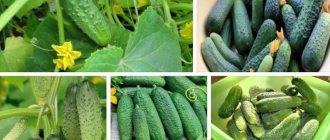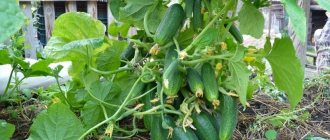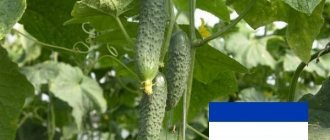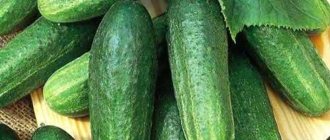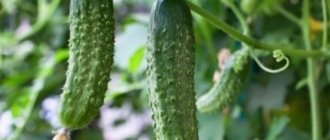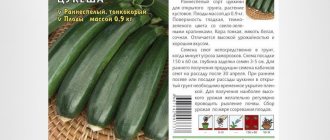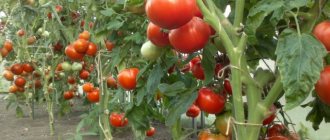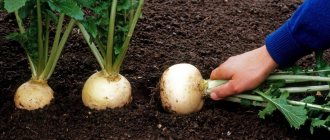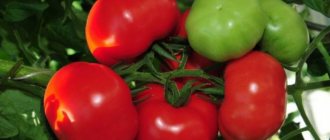Today, you can grow a decent harvest of cucumbers in a small space, for example, in front of the window of your own apartment in a small front garden or on a balcony. Those who have small garden plots can also get a full harvest, thanks to the emergence of a relatively new type of cucumber crop called “tufted cucumbers.” Even if you plant just a few bushes of these cucumbers, there is a chance not only to supply your family with fresh vegetables all summer, but also to make homemade preparations for the winter. In this article we will tell you about the best varieties of bunch cucumbers, their characteristics and cultivation secrets.
What are bunch cucumbers?
Cucumbers of this type have two names - bunch and bouquet. When a plant blooms, not one flower is formed in one bosom, like with ordinary cucumbers, but several - a whole “bouquet” blooms. When the fruits ripen, they come from one node, representing a “bundle” of cucumbers.
Bundle cucumbers ripen in clusters almost simultaneously - many “clusters” consisting of small greens hang on the stems of the cucumber bush. Most bouquet varieties have small gherkin-type fruits. In addition to bunched cucumbers, there are super bunched cucumbers, which are distinguished by a particularly large number of ovaries in a bunch - 8-10 or even more.
What are bunch (bouquet) cucumbers and what are the advantages of growing them?
Bundle cucumbers got their name due to the fact that in each internode they form several ovaries at once (from 3 to 10 or more) , which, when ripe, form bunches of greens .
By the way! Cucumbers with 8-10 or more ovaries are called super-tufted .
In ordinary varieties or hybrids of cucumbers , as a rule, 1-2 inflorescences are formed in the leaf axils.
Interesting! Bundle cucumbers are also often called bouquet cucumbers, because during the flowering process they form many flowers growing from one place (node), which is very similar to a bouquet. Therefore, this type of flowering is usually called bouquet.
Interesting! The axil is the place where the leaf leaves the stem. In this place there is a bud; either a shoot or a flower (ovary) can grow from it.
The advantages of growing bunched cucumbers are:
- High yield due to a large number of ovaries.
One plant with a bunched type of fruiting can produce a yield comparable to 2-3 ordinary plants.
- Mass ripening - simultaneous filling of fruits.
- The greens are small in size, usually gherkins or pickles. In other words, they are ideal for pickling and canning.
Classification
There are several types of bunch cucumbers. To make it more convenient for gardeners and vegetable growers to choose suitable varieties that meet specific requirements, bouquet hybrids have been conditionally classified.
Parthenocarpic varieties are not self-pollinating; they do not require pollination at all. Their ripe fruits do not contain seeds.
Classification of parthenocrapic bouquet varieties of gherkin type:
- Actively branching hybrids. Side shoots grow from almost every node on the main stem. Side shoots when grown in greenhouses need to be pinched. Intensive branching ensures long-term fruiting. These varieties tolerate overheating well. These include, for example, such hybrids as Dragonfly, Focus, Petrel, Matryoshka.
- Moderately and limitedly branching. They produce many short shoots with shortened internodes. They are distinguished by long-term fruiting and simpler bush formation. For example, these are such hybrids as First Class, Grasshopper, Ant.
- Weakly branching. These include ultra early ripening hybrids. Most of the harvest is harvested from them in the first month. These are hybrids Bouquet, Alphabet, Artel.
- Balcony. It is fashionable to grow on balconies and verandas. The main stem is vigorous, and the branching can vary from weak to strong. These hybrids differ from all existing varieties and hybrids: Many active ovaries - more than other bunch hybrids.
- Internodes are very short.
- The leaves are small.
- The fruits are pickle or gherkin, smooth, beautiful, regular in shape.
Actively branching cucumber hybrid “Dragonfly”
Actively branching cucumber hybrid "Focus"
Actively branching cucumber hybrid "Burevestnik"
Actively branching cucumber hybrid “Matryoshka”
Moderately and limited branching hybrid of cucumbers “First Class”
Moderately and limited branching hybrid of cucumbers “Grasshopper”
Moderately and limited branching hybrid of cucumbers “Ant”
Weakly branching hybrid of cucumbers “Bouquet”
Weakly branching hybrid of cucumbers “Alphabet”
Weakly branching hybrid of cucumbers "Artel"
Balcony variety of bunch cucumbers
Description of the variety “Beam splendor F1”
Cucumbers “Beam Splendor F1” are a parthenocarpic hybrid that does not require pollination to begin the growth of numerous ovaries. The cost of 5 seeds is 85 - 105 rubles (depending on the manufacturer). Two productive hybrids took part in the selection. Judging by the description of the “Beam Splendor” cucumbers provided by the manufacturer, you can count on a yield of up to 50 kg per m2.
In the female internode, 5-7 ovaries are formed simultaneously. Minimum quantity – 3 pieces. The cucumber variety “Beam Splendor” has no male internodes and weakly branches. Therefore, it does not need pinching and pruning in order to form an unthickened vine. Zoned for risky farming zones in the Urals and most of Siberia. Suitable for growing in film and polycarbonate greenhouses, greenhouses and tunnels. In open ground conditions it often reduces yield by up to 20 kg per m2.
In the description of the “Beam Splendor” cucumber variety, the manufacturer indicates the need for almost daily abundant watering with warm water. Large amounts of organic and mineral fertilizers are also required weekly. Without fertilizing, this variety will not give the expected yield and will completely disappoint the gardener. When loosening, do not go deeper than 5 cm. The root system is located very close to the surface of the soil.
General information about this variety of bunch cucumbers:
- fruit type – gherkin;
- the minimum length of greens is 5 cm, the maximum is 11 cm;
- The shape of the cucumber is cylindrical, without ribs, smooth;
- spines sparse, white;
- the color of the fruit is light green with faint white stripes;
- taste qualities are excellent;
- Suitable for salads, canning by salting and pickling.
In a greenhouse, it can yield crops due to the growth of new shoots before frost. Resistant to powdery rose, fusarium, brown spot, gray rot. Tolerates temporary drops in ambient temperature to +5°.
The cucumber “Puchkovoe splendor F1” in the photo is not much different from gherkins of other varieties, but its taste is excellent.
Advantages and disadvantages of bunch cucumbers
Advantages of bouquet varieties:
- Consistently high yields. One bush, depending on the variety, can produce 10-20 kg of cucumbers. The peculiarity of bunch varieties is the sequence of opening of flowers in the inflorescence. 1-2 flowers open per day. The plant maintains high yield potential and bears fruit consistently. The bush has “spare” ovaries in case of death of some of the ovaries due to unfavorable conditions - some ovaries will die, others will rush into growth, and the gardener will not be left without a harvest.
- The fruits are not prone to overgrowth. Due to high competition for food, fruits growing within one node do not outgrow, unlike cucumbers growing individually.
- A large number of fruits ripen at one time. At peak production, one plant can have up to 12-15 bunches of cucumbers suitable for harvesting. Just perfect for stocking or selling.
- Small fruits. The maximum length of the fruit should not exceed 15 cm. Cucumbers that are too long, collected in one node, may become distorted. Small fruits are convenient to use for pickles and canning. Bunch cucumbers are suitable for those who love pickled cucumbers.
- Resistant to temperature changes. During the seasonal period.
- Early maturation. The first fruits appear approximately 35-40 days after germination.
- Good taste. Cucumbers have universal uses.
The more cucumbers in one node, the slower their growth - this is very convenient for summer residents who only show up at their dacha on weekends.
There are no obvious shortcomings in bouquet varieties. Only summer residents who visit the site from time to time may encounter difficulties - bunch cucumbers require care, without it you cannot count on the benefits of such varieties.
Characteristic
Hybrids from the Pumpkin family are annual plants with a rather long stem, sometimes reaching 2 meters. They got their name due to the type of fruiting - bunch or bouquet, which looks like a bunch of mini-bananas. Small-sized gherkins or pickles ripen on the bushes.
Related article:
Why cucumber leaves curl - 8 possible reasons
Depending on the type of pollination there are:
- self-pollinating;
- parthenocarpic;
- bee-pollinated.
According to the intensity of branching, crops are divided into:
- strong - the most productive varieties with a long growing season and labor-intensive agricultural technology;
- medium – crops with a shorter harvest period and lower yield;
- weak - bushes with a minimum number of lateral shoots and the shortest growing season.
Fruits can have different pubescence:
- white-thorned - salad plants, distinguished by very delicate skin and juicy pericarp;
- black-shipped - ideal for canning; they have a hard skin that perfectly retains its shape.
Depending on growing conditions:
- hybrids for greenhouses;
- varieties for open ground;
- universal varieties.
Features of cultivation: ovaries and fruiting
Bunch varieties in open ground are grown in almost the same way as ordinary ones. But the peculiarities of growing are still present. In weak plants, the ovaries dry out and fall off. Weakened bushes cannot provide nutrition to all formed ovaries. To prevent this situation, the following measures are taken:
- Before planting, about a week before, compost (10-15 kg per 1 sq. m) and mineral fertilizers (30-40 g per 1 sq. m) are added to the beds for digging.
- The beds are watered the day before planting. Planting is carried out at a soil temperature of +10°C. Planting depth – 10 cm.
- The holes in which the seedlings are planted are disinfected with a weak solution of potassium permanganate.
- Seedlings are planted at intervals of 40-50 cm - bunch varieties do not tolerate crowding. The soil is mulched. The most suitable mulch is humus.
- Install trellises, it is advisable to stretch the net for cucumbers. The bush is formed by pinching the side shoots. Thanks to trellises, a higher yield of bouquet cucumbers is achieved.
- In the axils of the four lower leaves, all flowers and stepsons are removed. Two side shoots with ovaries can be left after pinching. The task is to form the bush so that the main stem produces the maximum yield.
- For irrigation use only warm water. The soil should not be allowed to dry out. Soon after moistening, the soil is loosened to provide the roots with oxygen.
- The roots of bunch cucumbers do not tolerate high concentrations of salts well, so fertilizers are applied in small quantities, but with great frequency. Thus, complex fertilizers are applied every week at 15 g per 1 sq. m. m. Organic matter is added every two weeks in the form of a solution of manure or bird droppings.
- In order for the plants to bloom better and form many ovaries, they are fed at the root from time to time.
- To obtain maximum yield, the fruits are harvested daily. Canes that have stopped bearing fruit are cut off.
The video below will tell you about the features of caring for bunch cucumbers when growing them:
Cucumber “Beam Charm”
Another interesting variety with bouquet flowering is the “Beam Charm F1” cucumber, used both for greenhouses and open ground. This is a parthenocarpic hybrid that does not require pollination for ovary growth. It is recommended to plant no more than 4 plants per m2 in open ground, and 3 in a greenhouse.
The fruit is a dark green gherkin with numerous black dots. The shape is cylindrical, without ribs, with spikes. The taste is pleasant, sweetish. Suitable for pickling, salting and preparing fresh salads.
Why is the number of ovaries decreasing and how to prevent this?
For intensive formation of ovaries, it is necessary to provide competent care. The following points have a negative effect on the formation of ovaries:
- a lot of nitrogen in the soil;
- irregular watering;
- overheating;
- lack or excess of sun.
The number of ovaries depends on the growing conditions. The largest “bouquets” are formed on trellises and well-lit shoots.
“Resorption of beams” is observed when:
- Intensive growth of the central stem. In the lower part of the plant, nodes often have more ovaries than in the middle tier - this phenomenon is observed at high temperatures. In favorable conditions, when the bush grows at a moderate pace, the number of ovaries gradually increases from the lower to the upper axils, and from the central shoot to the lateral ones. If fertilizing is not applied to the soil for a long time, or there is not enough of it for normal fruiting, the largest bunches grow in the middle part of the plant.
- Shading. Depending on the incidence of sunlight, the number of ovaries in the bunches varies. Some nodes may have 2-3 fruits, others - 8-10 or more.
To prevent a decrease in the number of ovaries, the following rules must be followed:
- The temperature should be maintained between +21 and +24°C.
- Avoid overheating the air, especially at night.
- Do not overload the soil with nitrogen fertilizers.
- Maintain uniform illumination of plants.
The plant is not able to “nourish” all the ovaries that are formed - it simply does not have enough strength, so a certain part of the ovaries dry out and die even under the most favorable conditions. And yet the principle applies - the more correct the agricultural technology, the higher the yields.
Features of growing bunch-type fruiting cucumbers
If you do not properly care for bunched cucumbers (follow agricultural cultivation techniques), then you can’t even dream of high yields.
The nuances of agricultural technology for growing bunched cucumbers are expressed as follows (perhaps, in a sense, they can be called disadvantages ):
- Good and uniform illumination and stable temperature conditions are required .
- High demands on moisture and nutrition - they need to be watered more often and fed regularly (at least once a week, preferably with complex mineral fertilizers such as Aquarin, Master, Fertika , which was formerly called Kemira). Also initially requires exceptionally fertile and loose soil .
Important! If you do not regularly feed the plants, you will lose a lot of ovaries, which will begin to turn yellow and dry out.
Potassium fertilizing is especially important, but nitrogen fertilizing is contraindicated during the period of ovary and fruiting.
- You need to constantly collect fruits - every other day or even every day.
Note! If you come to the dacha only for the weekend, then 1-2 greens in each bunch will outgrow, and the remaining ovaries will lack moisture and nutrition. Because of this, they will begin to turn yellow and dry out, in other words, overgrown fruits will restrain the growth of new ones.
Therefore, to realize the main advantage of growing bunched cucumbers, it is recommended to collect greens as often as possible and at a younger stage of the greens (pickles or gherkins). Only in this case will almost all of the ovaries be able to develop and the natural release of the ovary will occur to a lesser extent.
Thus, many gardeners agree that bunch varieties of cucumbers are, rather, for those who either live in the country in the summer or grow them in the garden of a private house. However, there are varieties with a bunch type of ovary formation that do not require such frequent care.
By the way! Indeed, many gardeners complain that there is too much hassle (for example, it’s trite that it’s not very convenient to harvest in bunches, because you can easily damage neighboring ovaries), and it’s much easier to grow ordinary varieties (hybrids), getting, in general, Well, a similar harvest.
Video: features of growing bunched cucumbers
Note! The number of ovaries in a node may vary depending on growing conditions and the location of the node on the plant.
Even in the most super-bundled hybrids, the number of ovaries in a node on a plant can vary from 2-4 to 10-11 or more.
Reduce the number of ovaries:
- excess nitrogen nutrition;
- overdrying of the soil;
- severe overheating;
- excessive shading.
This can be noticeable in the case of very rapid growth of the main stem (the so-called “bundle resorption” ). In the lower nodes of the main stem there may be more ovaries than in the nodes of the middle tier when the plants are “overfed” in hot weather.
Under optimal conditions, when plant growth is not too fast, the number of ovaries in a node increases from the lower nodes to the upper ones and from the main stem to the side shoots. Relatively low air temperatures, mainly at night (the soil temperature should be optimal: from +21 to 24 degrees), optimal conditions for the growth and development of plants contribute to an increase in the number of ovaries in the nodes.
By the way! The largest bunches are formed under the trellis , and on well-lit side shoots .
Secrets of growing bunched cucumbers
Growing bunch cucumbers has a number of secrets that help you achieve the maximum from productive hybrids.
Lighting
Bouquet varieties love light, but there are also those that can bear fruit in light shade. Lighting has a beneficial effect on the number of ovaries formed, so it is recommended to place cucumber beds in sunny areas, and when growing cucumbers in greenhouses, use artificial lighting if necessary.
If, when growing in open ground, the area is in partial shade, it is necessary to choose shade-tolerant hybrids.
The soil
Bouquet cucumbers get sick if there is stagnation of water in the soil. To prevent it, it is necessary to equip the beds with effective drainage.
The optimal soils for bouquet varieties are loose, nutritious soils with a structure that provides easy air flow to the root system.
Wind protection
Most garden plants react negatively to drafts. Bundle cucumbers are no exception. Cucumber beds are organized in areas protected from drafts and blowing winds, due to which the plants get sick, weaken and lose productivity.
Cucumber with bunched ovary “Garland F1”
Cucumber varieties with bunched ovaries of domestic selection are more promising for growing on a personal plot than seeds from Dutch producers. Bunch cucumber “Garland F1” is characterized by increased resistance to unfavorable growing conditions. It is suitable for both film shelters and open ground. Bouquet formation of ovaries occurs in each internode.
The parthenocarpic hybrid is characterized by a prolonged fruiting period. In a greenhouse it can produce a harvest until the end of September. In open ground, the formation of ovaries stops at the moment when night temperatures go beyond +10 °.
It belongs to early-ripening varieties with a bunched ovary - the first cucumbers can be harvested 50 days after emergence. Grown through seedlings. Sowing at home is done at the end of April. Planting in the ground - at the end of May. During this period, 3-4 true leaves are formed.
"Garland F1" are bunch-type cucumbers that are resistant to most common infections. Productivity is up to 18 kg per m2. Suitable for canning by pickling and salting. Can be eaten fresh. No pollination required.
Landing Features
Planting bouquet cucumbers can be done in open ground or indoors, with seeds or seedlings. In any case, the seeds are germinated.
Unlike conventional varieties, the seeds of bunch hybrids are not treated in stimulants and disinfecting solutions, but are only germinated.
Germination order:
- Immerse seeds in warm water. Temperature – from +30 to +35°C.
- When the seeds swell, they are transferred to a damp cloth. Seeds are germinated at temperatures up to +20°C.
- When the seeds sprout, they are planted in separate glasses. This is done in order to avoid picking and immediately plant the seedlings in the ground or in a greenhouse. If you pick, the plants then get sick for a long time and lag behind in development.
Soil for growing seedlings is bought in agricultural stores or prepared from semi-decomposed sawdust, peat and humus. The mixture is poured into glasses and filled with water. Then the germinated seeds are planted, deepening them to about 2 cm.
The soil - on the site or in the greenhouse, should be loose and light. When planting, the interval recommended for a particular variety is observed - crowding has a negative impact on yield.
Features of planting bouquet cucumbers in open ground:
- The soil for planting is prepared in the fall.
- Holes are made in the beds into which a solution of potassium permanganate is poured to disinfect the soil.
- Planting seedlings in open areas begins after the soil warms up to +10°C. The optimal depth is 10 cm. The interval between plants is 40 cm.
- Seeds are planted in open ground when it warms up to +10°C. The width of the beds is 70 cm. Furrows are made in them, into which seeds are sown at intervals of 40-50 cm. Three seeds are placed in one hole. The depth is the same as when planting seedlings - 2 cm. The planted seeds are watered and a film is placed on top. When the shoots appear, the film is removed and the plantings are thinned out, leaving the strongest shoot of the three that have emerged.
- The optimal growing method is vertical. A rope is pulled from each plant to a twine stretched at a distance of 2 m from the bed.
- During cultivation, bouquet varieties are sprayed with compounds that promote the formation of ovaries. For spraying, “Zircon” or “Epin” is used.
- The optimal time for sowing seeds for seedlings is the last days of April. Seedlings are planted in the ground at the end of May - the first two true leaves should appear on the seedlings.
- When planting seedlings in open ground, per 1 sq. m plant 3-4 plants, no more.
When growing in greenhouses, the most favorable conditions for the crop are created - humidity 90-95%, temperature during planting - +23°C, during flowering and formation of ovaries - +27°C.
Good and productive varieties of cucumbers
Varieties of bunch cucumbers are divided into:
- parthenocarpic varieties;
- insect-pollinated.
The first type is recommended for growing in greenhouses in winter, while the second type can be grown in open ground or under a film cover that can be removed.
Also, bunch varieties are divided into:
- weakly branched;
- with limited branching;
- with good branching.
Hybrids with weak branching are intended for cultivation in greenhouses and low greenhouses. For varieties with limited and good branching, large greenhouses are required, or they are planted in open ground.
For those gardeners who visit their summer cottages only on weekends, special varieties with slow fruit growth have been bred. Such plants can be harvested only once a week.
The peculiarity of such species is their miniature fruits, unpretentiousness and adaptation to any growing conditions.
If hybrids with only the female type of flowering are planted, in order to get a rich harvest, it is advisable to plant any pollinating variety nearby.
Snowstorm
This early parthenocarpic hybrid with a growing season of 37 days is intended for propagation in greenhouses. It is recommended to grow it using the seedling method. Its medium-sized plants have a predominantly female type of flowering. Side shoots are underdeveloped. One node can bear 5 or more fruits. Medium-tuberous cucumbers, only 6 - 8 cm long, begin to grow in width when they reach a size of 4 cm, therefore, they must be removed on time. The color of the fruit is heterogeneous: at the top it is much lighter than at the base. The pulp is crispy, juicy and tender, without bitterness, but sometimes voids form inside the fruit. Variety - universal use. Productivity - 15 kg per square meter. The hybrid is resistant to major cucumber diseases. Read this article on how to make a greenhouse for cucumbers.
In order for the harvest of cucumbers to be pleasing, plants of bunch varieties should be formed into one stem so that the side shoots do not take away the strength necessary for fruiting and filling the cucumbers.
Hybrid Detinets
The parthenocarpic hybrid Detinets is mid-early (vegetation period 40-45 days). Plants are of medium height and medium branching with a female type of flowering. In one leaf axil, 5-7 fruits are set simultaneously. Cucumbers grow up to 12 cm long. The color of the medium-tubercular fruits with brown pubescence is light green with yellowish stripes. The taste is juicy, without bitterness.
Productivity - 14 kg per square meter. This variety of cucumbers is consumed fresh and stored for the winter. The peculiarity of the hybrid is that fruit set does not occur in the first node.
Detynets is resistant to cladosporiosis. A variety intended for cultivation in greenhouses using the seedling method.
Tom Thumb
Boy with Thumb is a parthenocarpic hybrid of early maturation. Its growing season is 39 days from the moment of first shoots. Its peculiarity is the bouquet type of ovary, in which 6 or more fruits are formed. Plants are medium-climbing. Finely tuberous dark green fruits are up to 11 cm long and have crisp, juicy flesh, dense, without voids. The taste of cucumbers is without bitterness.
The use of the variety is universal. The hybrid is resistant to many types of cucumber diseases. It is very popular because, with high yields, it tolerates transportation well over long distances without losing commercial qualities, which allows this species to be grown on an industrial scale.
It grows both under film, on the balcony, and in open ground. The cultivation method depends on the climate and region in which the cultivation takes place.
In cloudy and rainy weather, the growth of ovaries in parthenocarpic plants is often inhibited. To speed up fruit filling, it is recommended to spray plants with “stress-resistant” preparations Zircon or Epin, and also pinch off side shoots, if any.
King of the bed
This hybrid is bee pollinated. It is recommended to grow it in open ground. The variety has powerful, vigorous plants, with medium-long shoots. Cucumbers, up to 11 cm long, are dark green with light stripes. The taste of the pulp is harmonious and very juicy, without bitterness. The fruits of this species are used fresh and stored for the winter. Read about the best varieties of cucumbers for pickling and canning here.
One node can immediately produce up to 5 fruits. The yield of the hybrid is average (6 kg per square meter). The variety is well resistant to disease and weather disasters. They are most often planted using the seedling method, but you can also simply sow dry seeds in open ground. Caring for plants is very simple, since the King of the Garden is a completely unpretentious hybrid, for which it is highly valued by gardeners.
Master - long-bearing variety
Master is a parthenocarpic hybrid of mid-early ripening (vegetation period 42-45 days) with predominantly female flowering. Plant branching is limited. The variety was developed relatively recently - in 2011. It is grown both in greenhouses and in open ground. 5-6 ovaries appear in one node at a time. Large lumpy cucumbers of a rich green glossy color, up to 11 cm long, have high taste and pickling qualities.
The hybrid is quite resistant to diseases and also tolerates both cool weather and heat. The fruiting period is quite long (from the beginning of July to the end of September). In the southern regions, seeds can be planted directly in open ground; in areas with a cool climate, the seedling method of cultivation is practiced.
Before planting seedlings, the seeds of bunch varieties are soaked for 5 hours in warm water, and then laid out on damp cloths until germination, only then planted in separate cups. In this way, the germination rate of seedlings is increased.
Tufted Robin Hood
Parthenocarpic early hybrid with weakly branched, medium-sized plants and a bouquet-type ovary, in one node of which 5 fruits appear at once. Large-tubercular gherkins with black spines and light stripes do not reach a length of 6 cm. Their flesh is dense and very juicy, without bitterness. Cucumbers are suitable for fresh consumption and for home canning.
The average yield of the hybrid is 6.5 kg per square meter.
Robin Hood is resistant to major cucumber diseases and is also very easy to care for. It is successfully cultivated both in the south and in the northern regions. It is grown both by seedlings and simply by seeds.
Hybrid Okhotny Ryad
The Okhotny Ryad variety is a parthenocarpic with a female type of flowering. Its growing season is 37-40 days from the moment of first shoots. The growth of lateral shoots of plants is limited, especially when they are heavily loaded with fruits. The highest yield of the variety is at the very beginning of fruiting. 6 or more cucumbers are simultaneously tied in one leaf axil. Medium-sized, slightly lumpy, white-thorned fruits (up to 11 cm), have excellent taste. Used for preparation and fresh consumption. The variety is resistant to almost all existing cucumber diseases, except downy mildew.
The hybrid is grown by seedlings. It grows well both in greenhouses and in open space, and is also completely unpretentious in care.
If the plants of the Okhotny Ryad variety grow strong and powerful, but the fruits do not set on them, in this case it is recommended to pinch the ends of the central shoots.
Cucumber care
Caring for bunched cucumbers involves regular watering, spraying, fertilizing, loosening, and the formation of bushes. If cultivation is carried out in a greenhouse, you have to control the temperature and humidity, and ventilate the room in a timely manner.
Feeding
When fruiting begins, cucumbers require a lot of nutrition - they need minerals. The roots of this crop do not tolerate high concentrations of salts in the soil, so cucumbers are fed in small doses.
The frequency of feeding is once a week or even more often. Complex fertilizers are applied little by little - 10-20 g per 1 square meter. m. If cucumbers are grown in a greenhouse, it is recommended to install a container with fermenting grass or slurry in it. Thanks to the carbon dioxide released during fermentation, cucumbers ripen faster.
Watering
To water cucumber beds, use warm, settled water. Until the fruit is formed, the cucumbers are watered every 6 days. During harvest, the frequency of watering triples - the beds are moistened every 2 days. Cucumbers are watered only at the root; the optimal method of irrigation is drip irrigation.
In order for the plant to produce 15-20 kg of cucumbers, it must be prepared for this. A cucumber bush must have a powerful root system, a strong stem and healthy leaves - only such plants are capable of producing numerous ovaries from which fruits will develop.
Shelter
If there is no greenhouse on the site - after all, its construction requires certain costs, you can limit yourself to a temporary film shelter. At the beginning of the growing season, cucumbers are kept under film tunnels so that the plants do not freeze during possible night frosts. In addition, plants will grow and develop faster under the film, since under it there will be no significant drop in temperature, which is observed at night in open ground.
Formation on a trellis
Hybrids with bunched ovaries are formed into one stem - so as not to spray the plant’s forces on the side shoots. This approach increases productivity. The best way to grow bouquet varieties is on trellises.
Principles of bush formation:
- The side shoots are removed almost to the trellis.
- You can leave a couple of shoots with ovaries near the trellis, pinching them above the 2nd leaf.
- In the axils of the 4 lower leaves, all ovaries and shoots are torn off. The ovaries are left on the stem with each node having one leaf.
We invite you to watch a video that clearly shows how to correctly form a bush of cucumbers with tufted and supertufted ovaries:
What to consider when growing hybrids
When growing bunch hybrids, it is important to follow some rules. They will help you reap a rich harvest and prevent many problems.
Wind protection
To plant vegetables, choose an area that is reliably protected from draft winds.
Soil composition and structure
Cucumbers develop well in fertile, loose, light soil with a neutral acidity level.
There should be no stagnation of water, so drainage is organized at the bottom of the bed. It is also important to choose a site where groundwater does not pass close.
Shelter
The plant develops many ovaries that need to be constantly nourished. It is important that at the beginning of fruiting there is a strong root system, healthy stems and large leaves. Only such a bush can provide the green plants with the necessary set of microelements.
It is better to grow cucumber seedlings in a greenhouse or keep them under film until the threat of frost has passed.
Lighting
Cucumbers with bunched fruit growth should be planted in open areas of the ground, where the sun's rays penetrate without obstacles all day long. If the area is in the shade for some part of the day, it is better to choose shade-tolerant varieties.
Diseases and pests
One of the important advantages of bunch cucumbers is resistance to diseases and pests. But not a single variety is immune from them. Under unfavorable conditions, powdery mildew and other cucumber diseases may occur.
Diseases and pests of bunch cucumbers and measures to combat them:
| Diseases/pests | Signs of defeat | How to fight? |
| Powdery mildew | White spots cover the leaves. The plants look like they've been dusted with flour. | Diseased leaves are cut off and placed in a solution of copper sulfate - it is necessary to destroy the fungal spores. Plants are sprayed with colloidal sulfur (30 g per bucket). After 10 days – re-treatment. |
| Downy mildew | First, yellow spots appear on old leaves, then on young ones. The leaves turn brown and dry out. | Spray with Oxychom (40 g per bucket of water) or Bordeaux mixture (100 g per bucket). For 10 sq. m – 1 liter of solution. The treatment is repeated after 10 days, but no later than 20 days before harvesting the fruits. |
| White rot | The affected fruits are soft and slippery, with a white coating. | If growing in a greenhouse, ventilation and reducing air humidity are recommended. The affected parts of the plants are cut off, and the sections are sprinkled with sifted ash. Plants are sprayed with a solution of copper sulfate and urea (2 tsp and 1 tsp per 10 liters of water, respectively). |
| Greenhouse whitefly | The butterfly lays larvae on the underside of leaves. The larvae suck the juices from the leaves and secrete a sugary compound on which the fungus settles, causing the leaves to turn black. | As soon as butterflies appear, the plants are sprayed with verticillin (250 g per bucket of water). The plantings are treated 3 times at weekly intervals. You can also set up sticky traps. Whiteflies love the smell of tobacco; you can plant tobacco bushes near the cucumbers. When a lot of butterflies gather on them, the plants are sprayed with an insecticide, for example Intavir. |
Watch a video about biological diseases of cucumbers and ways to prevent them:
How to choose a variety
To choose the right variety of bouquet cucumbers, you must adhere to the following recommendations:
- First of all, you will need to clearly decide on the place for cultivating crops. As a rule, the packaging with planting material will indicate the preferred planting option.
- It is important to pay attention to the method of pollination of bushes. Bee-pollinated hybrids can be difficult to grow in greenhouses. They need to attract insects or hand pollination. Self-pollinating and parthenocarpic varieties will require less labor.
- The choice should also be made taking into account the preferred timing of harvest. It will be possible to collect vegetables from early-ripening varieties already in July, mid-ripening ones will be suitable for consumption in August, and late-ripening ones - in September.
Related article:
Why cucumbers don't grow - gardener mistakes
Harvest
It is recommended to collect fruits every day. Or at least every two days. Frequently removing cucumbers lightens the stem and creates favorable conditions for the formation of new ovaries.
When it comes to harvesting, bunched cucumbers are versatile. Frequent harvesting promotes yield, but harvesting once a week is not catastrophic - it’s just that new fruits will form more slowly. This is especially important for summer residents who deal with gardening matters only on weekends.
Cucumbers “Beam landing F1”
Another variety worthy of attention is the “Beam landing F1” cucumbers; their brief description is presented below. These are gherkins of slow growth, which is very convenient for summer residents who are not able to come to their plots during the working week. It is enough to harvest once a week. And at the same time, the cucumbers will not outgrow.
Basic information about “Beam landing” cucumbers:
- the minimum length of the fetus is 6 cm, the maximum is 10 cm;
- hybrid type – parthenocarpic (does not require pollination);
- male internodes – absent;
- the fruiting period begins 40 days after emergence;
- number of ovaries in one internode – 7 – 9;
- yield per plant – 22 – 24 kg;
- fruit color – rich green with black dots;
- fruits without bitterness, sweetish taste;
- Suitable for salting and pickling, and eating fresh.
Reviews from gardeners
★★★★★
Valentin R., amateur gardener, Moscow region. Bunch varieties take up little space.
I planted only 6 bushes in the garden, but the harvest was huge. I've never seen cucumbers grow in bunches before. At the beginning of the growing season, I cover the seedlings with film, so I remove them. ★★★★★
Irina L., summer resident, Belgorod region. I have already planted several varieties of bunch cucumbers.
Or rather, hybrids, so you have to buy seeds every time. Cucumbers grow small and are tasty; we eat them fresh and make a lot of preparations. I roll it up in jars and salt it in tubs. The smallest variety I grew was Karapuz, and I also liked Little Thumb. Hide
Add your review
Bundle cucumbers undoubtedly deserve the attention of gardeners. Their productivity and unique characteristics of fruiting, supported by high immunity, attract both summer residents and gardeners who grow cucumbers for sale.
0
0
Copy link
Bunch varieties for open ground
For the first time, bunched cucumbers for open ground began to be used approximately 20 - 25 years ago. But these were the first experiments. It was possible to get 2 ovaries in one internode. And even this increased the yield by 70%. At that time, such varieties as “Shchedry 118”, “Altaisky Early”, “Rodnichok F1” and “Dolzhik” gained popularity. These were short-fruited hybrids of mixed flowering type and partially requiring pollination. They still have high resistance to fungal and bacterial infections and various rots. Due to their early ripening, they can produce crops before the period of lower night temperatures sets in, i.e. until the end of August.
Modern varieties of bunched cucumbers for open ground produce up to 8 ovaries per node. 6-7 of them mature with properly organized care. We advise you to try growing in open ground such varieties of bunched cucumbers as “Three Tankmen F1”, “Tom Thumb F1”, “Buyan F1”, “Junior Lieutenant F1”, “Maryina Roshcha F1”, “Chistye Prudy F1” and others.
When planted in a timely manner in soil well fertilized with organic matter, each bush will grow up to 300 small cucumbers. This is a profitable crop that is worth trying to grow in your garden. We’ll talk about other varieties of bunch cucumbers later in the article.
For now, we suggest looking at the varieties of bunched cucumbers in the photo, which illustrates healthy, well-groomed plants:
Reviews
Beam and super-beam cucumbers are popular among summer residents due to their early ripening, excellent fruit taste and easy care.
Valentina, Voronezh: “I have been cultivating cucumbers for more than 10 years. I plant mainly parthenocarpics with bunch fruiting in open ground. One of the best hybrids for me is Thumb Boy. In the summer I live in the country and harvest every other day. There are always a lot of cucumbers, the size is the same. The fruits are aromatic, crispy, and not bitter. Maintenance is simple: drip watering, fertilizing with mineral compounds, molding with a tie to the trellis.”
Vladislav, Orel: “I grow bunched cucumbers both in the greenhouse and in the garden. I come to the dacha on weekends. I harvest in buckets. My favorites are Blizzard and King of the Garden. Installed a drip irrigation system on the site. I fertilize with complex liquid mineral preparations.”
Necessary care
Despite the fact that bunching is a genetic factor, the number of ovaries depends largely on cultivation conditions and plant health. Excess nitrogen in the soil, lack of watering, severe overheating, and too rapid growth of the main stem reduce the number of green plants formed.
Feeding
Bunch cucumbers need feeding more often than regular varieties. Complex mineral fertilizer is added during watering weekly in small doses - 10–20 g per square meter of plantings. When the number of ovaries decreases, feeding is reduced.
See also How to get rid of aphids on cucumbers: effective folk remedies and preparations
Watering
Water bunched cucumbers once every two days or daily if it’s hot. Focus on the top layer of soil; it should remain moist, but not overly flooded with water. On waterlogged soils, cucumbers grow green foliage to the detriment of flowering.
It is better to water in the evenings, when the sun has set, or in the early hours, so as not to burn the leaves through the “lenses” of the drops remaining on them. The water should not be cold.
Shaping and garter
Plants of bunch varieties begin to form a week after planting cucumber seedlings, when 8-9 leaf blades appear. In bunched hybrids, lateral shoots appear in the leaf axils along the entire length of the main stem. If left, thickening will negatively affect the number of ovaries per node, as well as the growth of fruits on the main stem. Therefore, they are usually formed into one stem. This increases productivity, saves labor costs, and improves the taste of the fruit.
Working technology:
- the lower 4-6 nodes blind in advance, even before the start of flowering, pluck out the buds of lateral shoots and female ovaries from the leaf axils. This will allow the plants to grow faster and develop powerful leaves. Those seedlings that were lagging behind in development will take root well;
- Along the main stem, the lateral shoots are then removed until the beginning of the trellis wire. They do this while they are small (they have not outgrown 3-5 cm). Leave 2-3 shoots on the main stem under the trellis, before pinching them into 2 leaves;
- when the top of the shoot grows to the top of the trellis, it is wrapped around the wire a couple of times;
- if it reaches a neighboring plant, it needs to be pinched.
In this way, nutrients are redistributed in a bunched plant and the filling of greens on the main stem is stimulated (it should be taken into account that the share of the harvest from it in bunched hybrids is usually no less than 60%). Removing side shoots at the bottom and middle part of the main vine promotes good aeration and illumination of the lower leaf blades.
If you carry out the formation of bunch varieties in the manner described above, fruiting will occur a couple of days later, but within a week the yield will be 2-3 times higher than without it.
Prevention from insects and diseases
Fortunately, most varieties of bunch hybrids have stable immunity to the main diseases of the crop, and their early ripening period guarantees that harmful insects, the main period of development of which occurs at a later date, will not cause them damage. However, to further reduce the risk of disease, it is worth taking appropriate preventive measures:
- observe crop rotation (when the same crop is cultivated annually, certain types of pests and pathogens accumulate in the soil);
- carefully remove weeds not only inside greenhouses, but also around them, since many pests find refuge there;
- remove old, dried fruits and flowers from the ovaries;
- maintain the healthy state of plants by timely watering and fertilizing;
- regularly inspect them, especially along windows and paths, for timely identification of pests.
It is very important to maintain temperature and humidity conditions if bunch varieties are grown in a greenhouse. Despite the fact that they love warmth and moist soil, overheating reduces the number of ovaries formed, and constant dampness is fraught with the development of putrefactive processes on the roots.
Varieties for greenhouses
To obtain a harvest in harsh climates, as well as to cultivate bouquet cucumbers throughout the season, hybrids were bred that develop well in greenhouse conditions.
Avalanche F1
An early ripening vegetable, in which from 4 to 6 greens are formed in one bunch. The growing season lasts about 40-45 days. Cucumbers do not exceed 10 cm in length. They are a universal crop.
Bogatyr strength F1
Popular due to its long growing season and high yields. On average, up to 8 ovaries are formed in one bunch. The fruits are quite large in size - reaching 15 cm in length.
Green wave F1
One of the most productive hybrids. A greenhouse variety that is resistant to most viral diseases. About 10 fruits are formed in one node.
Related article:
This will help prolong the fruiting of cucumbers in the greenhouse.
Excelsior
A culture of Dutch selection, it bears fruit in greens up to 12 cm long, with a maximum of 8 ovaries formed in each bunch. The harvest can be used for canning or pickling, for consumption immediately after harvest. Stores well and is suitable for long distance transportation.
Ajax F1
A vegetable of Dutch selection, it is in demand due to its high taste qualities. Zelentsy reach a length of 10-15 cm, the weight of one fruit is 100 g.
Piccolo F1
An early-ripening variety that develops well and bears fruit consistently in greenhouse conditions. Self-pollinating bushes can be harvested already 40 days after planting the seedlings in the ground. The plants are unpretentious in care, rarely suffer from fungal infections, and fruiting is stable.
Mother-in-law F1
An early ripening crop, it forms up to 4 ovaries in a bunch. On average, the weight of one vegetable is 100 g. Among the positive characteristics, it is worth noting immunity to fungal infections, as well as the ability to develop even with low marks on the thermometer.
Related article:
Everything you need to know about cucumber crops
How to harvest correctly
Fruits from bunched hybrids are collected frequently - daily or every other day. Overgrown specimens inhibit the growth of new ones. If visiting the estate is possible only once every few days, then choose gherkin-type varieties. A large number of ovaries on them inhibits the growth and outgrowth of green plants.
The best time to collect fruits is early morning or late evening. At this time they are more elastic due to the abundance of moisture. Usually, cucumbers are plucked off with your fingers, although it is more correct to use pruners or a knife for this, leaving the stalks on the vines. When collecting, do not pull the vines or tug them, so as not to damage the root system, and also try not to turn the leaves over - cucumber bushes do not like this.
